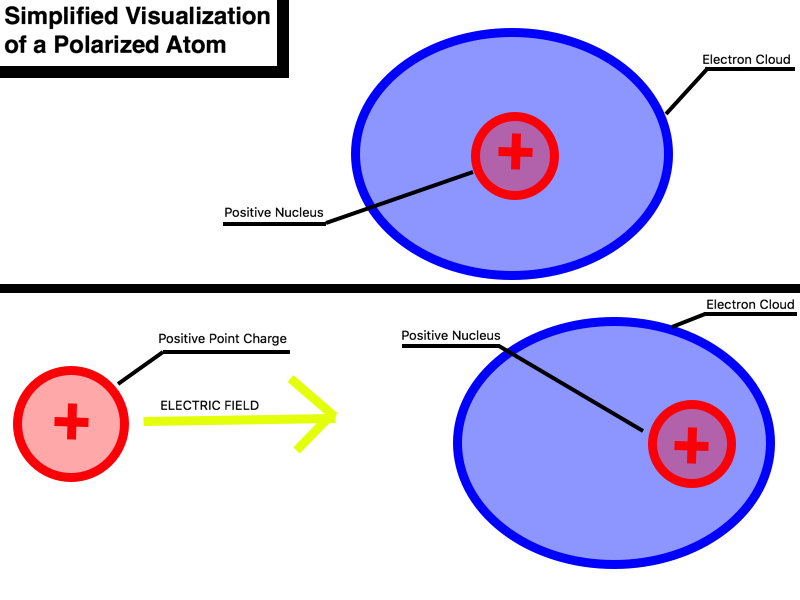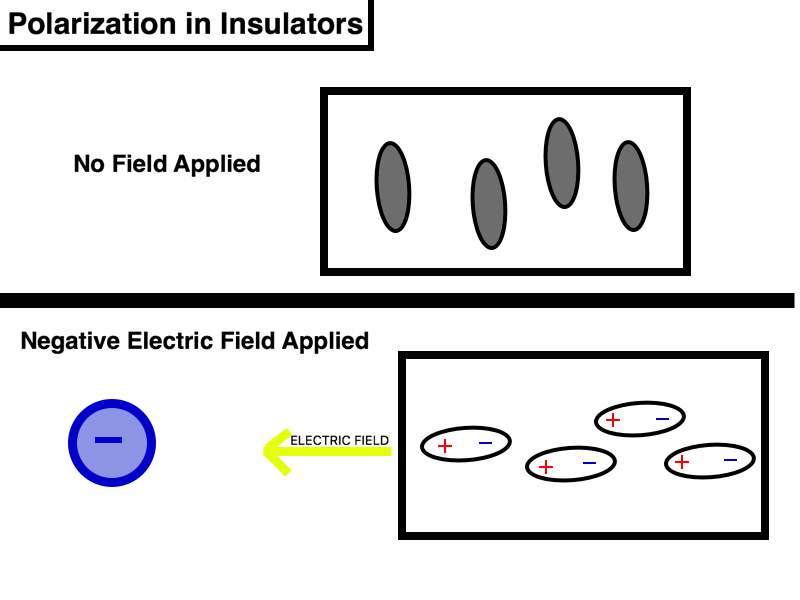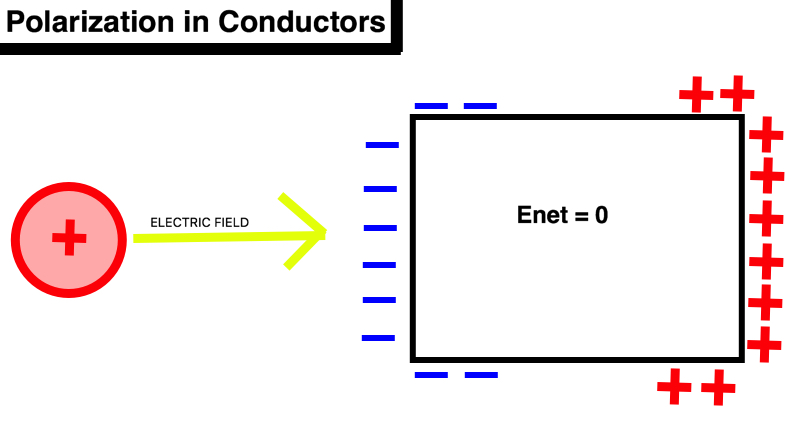Polarization: Difference between revisions
Lwinalski3 (talk | contribs) |
Lwinalski3 (talk | contribs) |
||
| Line 103: | Line 103: | ||
http://www.innovateus.net/science/what-polarization | http://www.innovateus.net/science/what-polarization | ||
http://www.physicsclassroom.com/class/estatics/Lesson-1/Charge-Interactions | |||
Matter and Interactions Volume II. | Matter and Interactions Volume II. | ||
Revision as of 18:58, 17 April 2016
Written By: tkapadia3 - Tapas Kapadia
Edited By: lwinalski3 - Laura Winalski
Polarization is defined as "the process of separating opposite charges within an object" by the application of an electric field. When the positive and negative charges within an object have become separated, the object is said to be polarized. Due to the physical separation of its positive and negative charges, a polarized object becomes a dipole, so long as the charge separation continues. Once the electric field causing the polarization is removed and the positive and negative charges are no longer separated, the dipole disappears. For this reason, the process of polarization is said to create induced dipoles. Polarizability is the ease with which the charges in an object can be separated. Polarizability is a constant value, determined experimentally, and is unique to each particular material. The amount of polarization an object experiences, or the dipole moment, is equal to the the polarizability multiplied by the magnitude of the applied electric field. Polarization occurs differently in insulators - materials through which mobile charges cannot flow - and conductors - materials through which mobile charges can flow. It is important to note that the process of polarization in and of itself does not induce charging. Polarization is the redistribution of charges throughout an object; a polarized neutral object is still a neutral object regardless of whether it is an insulator or conductor.
The Main Idea
At the atomic level, the application of external charges causes the subatomic particles, namely, positively-charged protons and negatively-charged electrons, to reorient with respect to the applied charge. The external application of a positive charge on the left side of a molecule will result in the electrons moving to the left, as they are attracted to the positive charge, and the protons moving to the right, as they are repelled by the positive charge. Similarly, the external application of a negative charge on the right side of a molecule will result in the protons moving to the right, as they are attracted to the negative charge, and the electrons moving to the left, as they are repelled by the negative charge. (See Charge Interaction)
The externally applied charges are, in truth, electric fields. Positive electric fields point outwards, away from the source, or the object creating the field. Negative charges, on the other hand, create inward pointing electric fields that point towards the source of the field. The external application of a positive electric field to an object will create an outward field, resulting in the movement of the electron closer to the external positive charge and the positively-charged nucleus further away from the external charge. With the charges physically separated in space, an induced dipole forms. When the external positive charge is removed, the induced dipole disappears and the object is once again neutral. This is drastically different from permanent dipoles, in which the positive and negative charges are always physically separated. Polarization and the resulting creation of induced dipoles helps explain the seemingly magical attraction between charged objects and neutral object. A charged object produces an electric field that, when brought near neutral objects, generates induced dipoles. The protons and electrons reorient themselves in the presence of the charged object's electric field and attractive forces can be observed between the two objects.
Polarization in Insulator: One main property of insulators is that electrons are tightly bound to the molecules. Therefore, there is no "sea of electrons" and the polarization happens much like what is shown below in which the actual atoms do not move very much but rather just reorient themselves to point correspondingly to the charges on or in the insulator. The net electric field is not equal to zero in the an insulator if there is a net electric field acting upon it.
Polarization in Conductors: Polarization in conductors differs from polarization in insulators because conductors have charged particles that can move throughout the object. While insulators have atoms that simply reorient themselves, conductors have charged particles that can move distances due to external charges applied upon the material. The speed in which these mobile charges move due to an applied electric is known formally as drift speed. The drift speed is equal to the the net electric field at the location of the charge multiplied by a the mobility of the mobile charges. Another important property of conductors is that excess charges are always located out the outside on the surface of the conductor. Because the polarization causes the mobile charges to reorient on the surface, the net electric field always goes to zero. This state is known as equilibrium, and it features a electron drift speed equal to 0. The electric field of the polarization of the charges cancels out the electric field applied which which leaves no net electric field inside a conductor when it is at equilibrium.
Polarizability
A Mathematical Model
What are the mathematical equations that allow us to model polarization?
Electric Force: [math]\displaystyle{ \vec{F} = q\vec{E} }[/math] Where "F" is the electric force, "q" is the charge, and "E" is the electric field.
Dipole Moment: [math]\displaystyle{ \vec{P} = \alpha \vec{E} }[/math] Where "P" is the dipole moment, alpha is the polarizability (different for every material), and "E" is the applied electric field.
Drift Speed: [math]\displaystyle{ \vec{v} = \mu E_{net} }[/math] Where "v" is the drift speed, mu is the mobility of the charge, and "Enet" is the magnitude of the net electric field.
Examples
Simple
Determine if the statements below are True or False:
1. There are mobile charges conductors.
2. The net electric field is equal to 0 in both a conductor and insulator when at equilibrium.
3. Excess charge is located only the surface of insulators.
4. The average drift speed is of a mobile charge is proportional to the magnitude of the net electric field the material.
1 is true. There are mobile charges in conductor. It is insulators that do not have mobile charges.
2. False. The net electric field is 0 at equilibrium only in conductors. It is not the case in insulators.
3. False. The excess charges of conductors are located on the surface. In insulators, the excess charges are anywhere on or inside the material.
4. True. This is the formula for drift speed. [math]\displaystyle{ \vec{v} = \mu E_{net} }[/math]
Middling
Does a negatively charged rod cause the metal sphere to polarize? If so, show the polarization of the neutral metal sphere, describe the electric field, and electric force caused by the negatively charged rod displayed below.
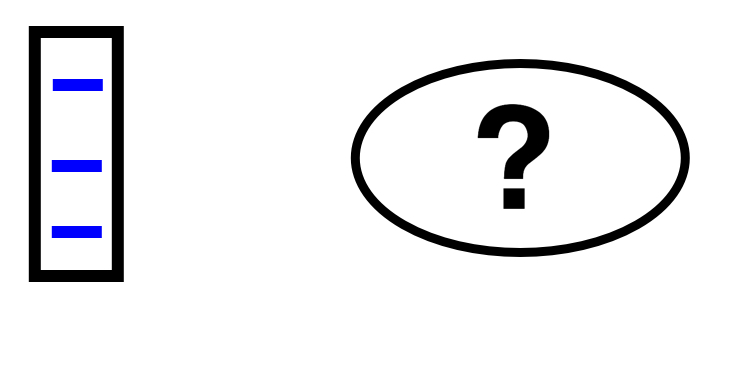
The electric field is toward the negatively charged rod. The electric force is pointed toward the charged as well. Thus the negative mobile charges are pushed to the surface of the far side of the sphere. The polarization essentially makes one giant dipole which has a net electric field of zero inside the sphere.
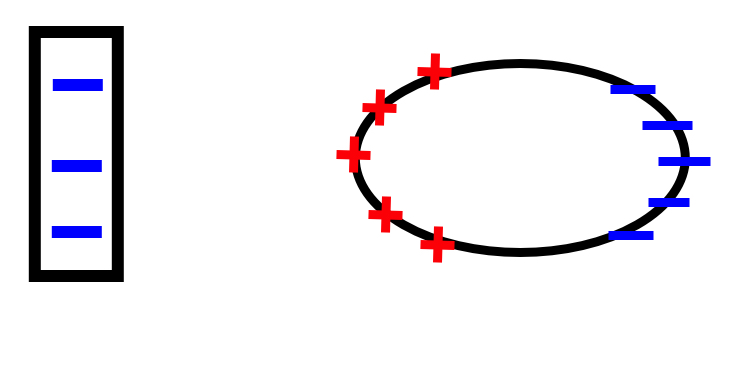
Difficult
Find and show the polarization on Block B and Sphere C is Sphere A is plastic sphere with a positive charge. Block B is natural metal block while Sphere C is plastic sphere.
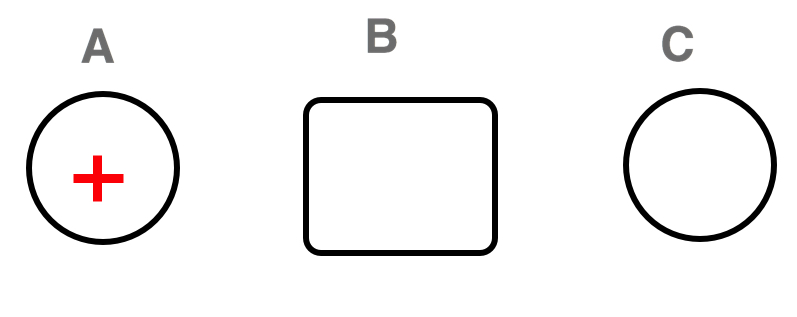
The positive charge of Sphere A creates a electric force which drives the positive mobile charges on away while attracting negative surface charges on the block. Due to this electric force the polarization on the block looks as it does below. The polarized block has positive surface charges near sphere C. Sphere C, however, is a conductor which means that there are no surface charges on Sphere C. In sphere C, a reorientation takes places. The negative ends orient close to the positive surface charges.
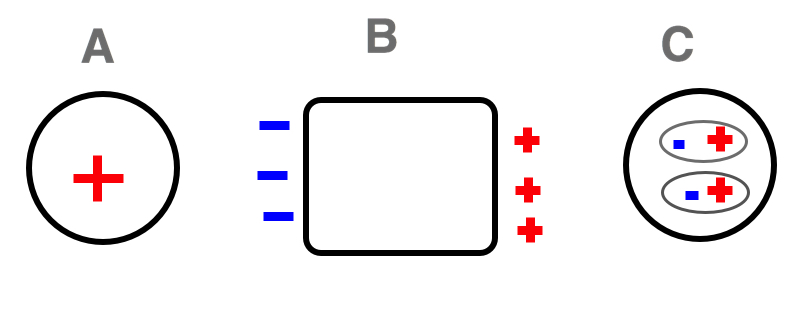
Connectedness
- How is this topic connected to something that you are interested in?
I have always been fascinated that something that is not charged could be attracted to something that is charged. Polarization explains this at a fundamental level which is something I find interesting. Learning how things at the the subatomic level is always fascinating for me.
- How is it connected to your major?
I am a computer engineering major. Honestly, I am not sure yet what Computer Engineering is all about. However, I am aware the polarization is an important concept in electrical engineering. Polarization of light waves seems to be more connected to my major.
- Is there an interesting industrial application?
The concept of polarization itself has many industrial applications. It is seen in 3D Glasses, Infrared spectroscopy, polarized sunglasses, FM radios, and even laptop screens. There are many, many industrial applications.
History
Polarization was discovered by Etienne Louis Malus. Etienne Louis Malus was a French physicist in the early 1800s who used concept that light is the range of electromagnetic radiation that humans cannot see to discover the concept we now know as polarization.
See also
Electric Field. Electric Force. Charge Density.
Further reading
Matter and Interactions Volume II.
External links
http://www.physicsclassroom.com/class/estatics/Lesson-1/Polarization
http://www.britannica.com/science/electric-polarization
https://www.youtube.com/watch?v=HKgOpmX-OFI
https://www.youtube.com/watch?v=5O0yWvQhWkU
References
http://www.physicsclassroom.com/class/estatics/Lesson-1/Polarization
https://arago.elte.hu/sites/default/files/DSc-Thesis-2003-GaborHorvath-01.pdf
http://www.britannica.com/science/electric-polarization
http://www.innovateus.net/science/what-polarization
http://www.physicsclassroom.com/class/estatics/Lesson-1/Charge-Interactions
Matter and Interactions Volume II.
https://www.youtube.com/watch?v=HKgOpmX-OFI
http://www.physicsclassroom.com/class/light/Lesson-1/Polarization
(I made the figures; I did not steal them from online)
